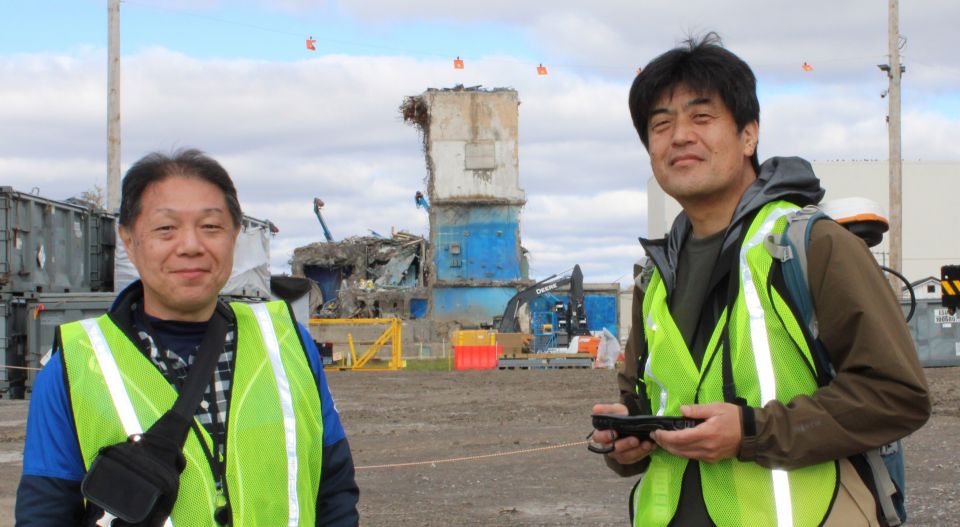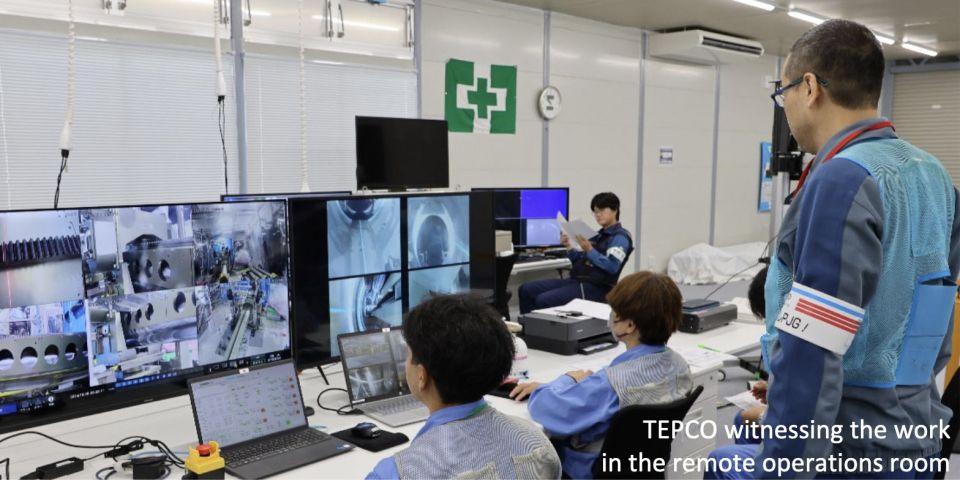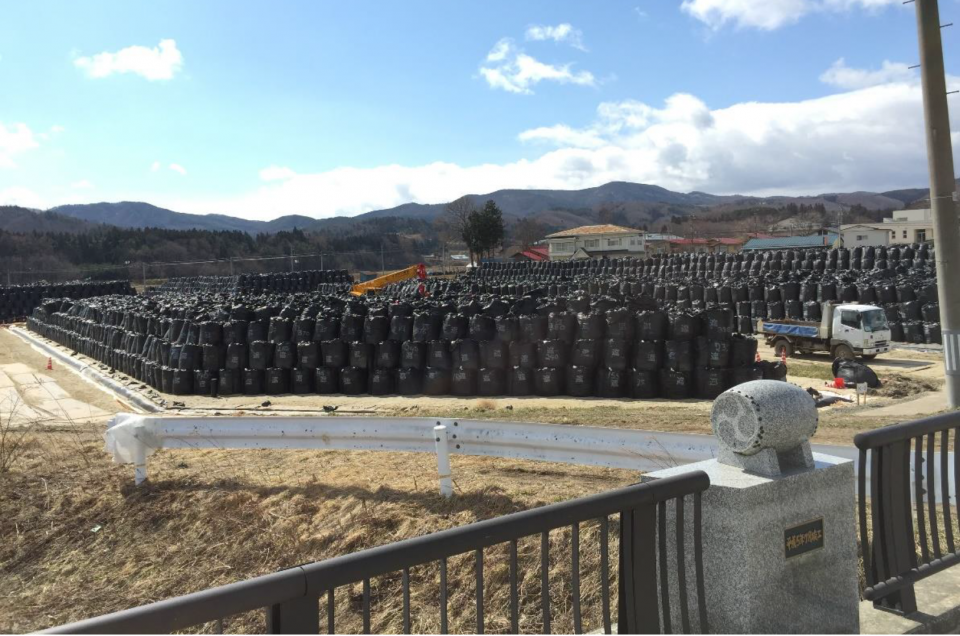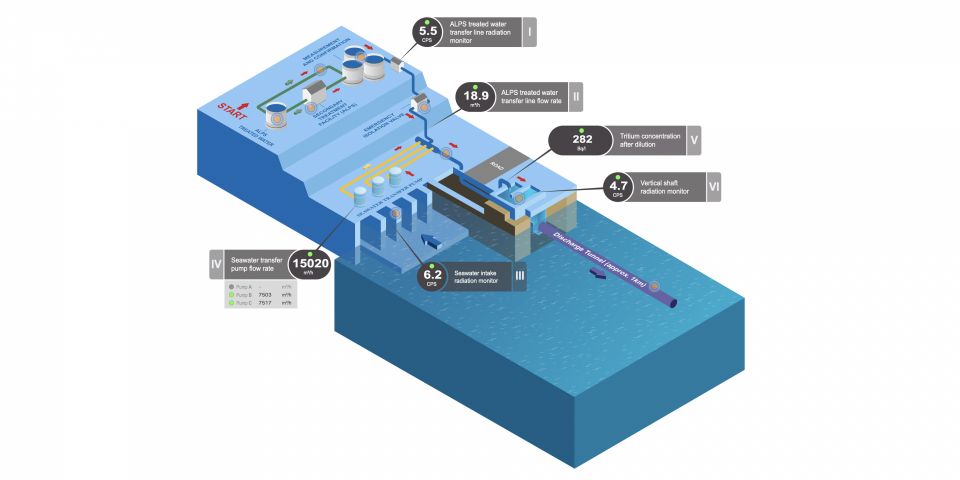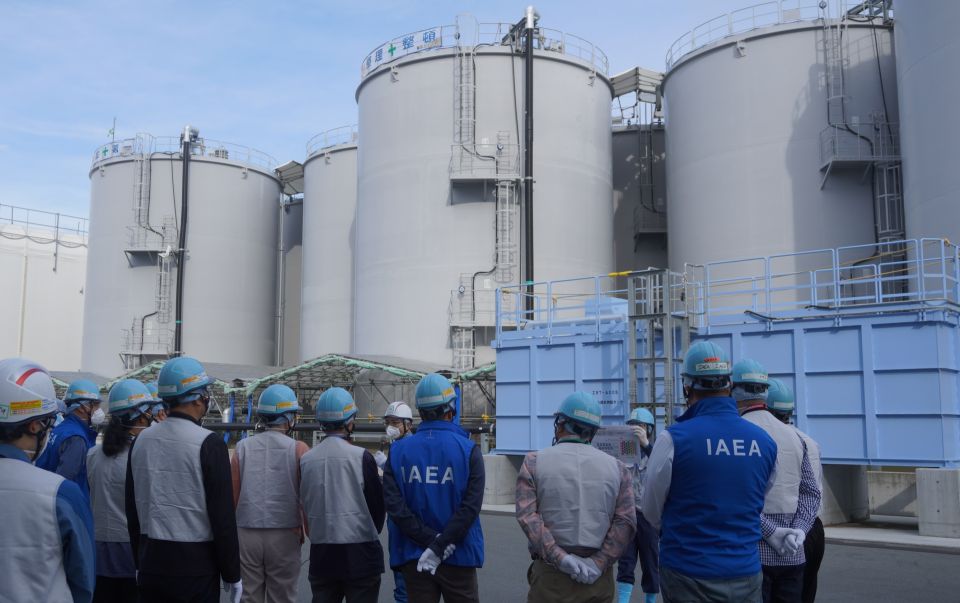Fukushima Three Years Later
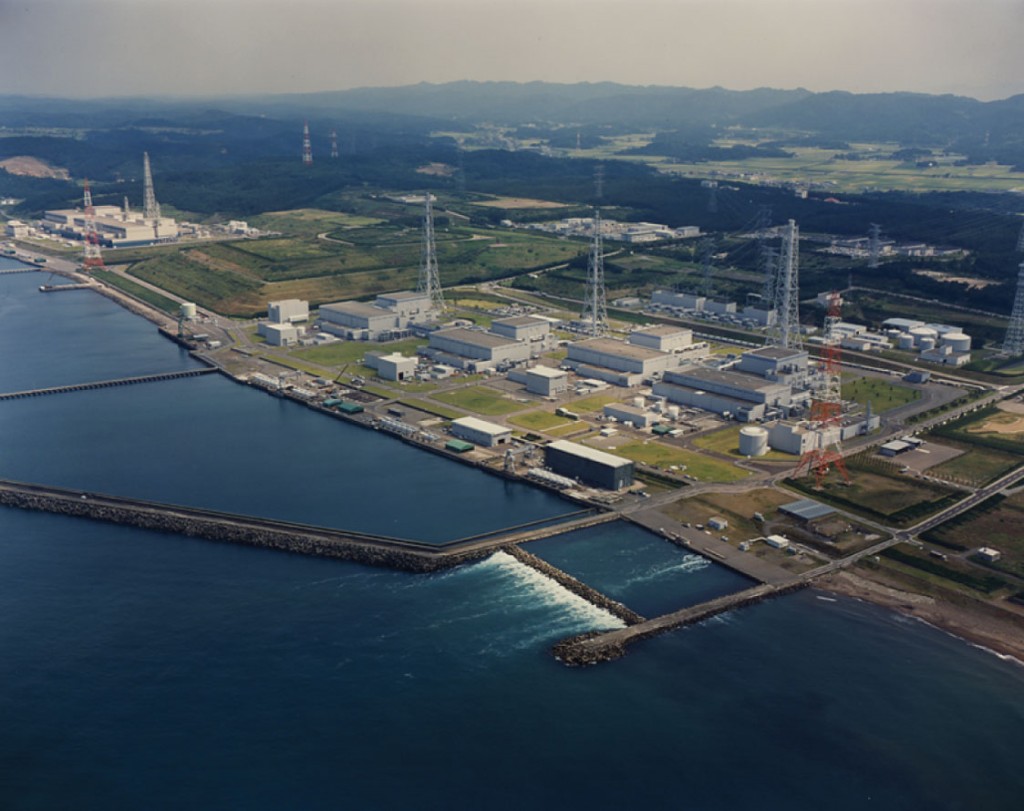
Tokyo Electric Power Company's Kashiwazaki-Kariwa Nuclear Station; Units 6 and 7 were submitted for safety screening in September 2013.
In our collective memory, disturbing images played out on video around the world in the days following the apocalyptic Great Tohoku Earthquake and Tsunami have somewhat receded, even if they haven't lost their impact-images of rushing waters, floating vehicles, buildings and debris, massive (and unstoppable) outbreaks of fire, and implications of lives lost and lives ruined.
Peculiar among these images, however, are those refreshed by their association with the nuclear accident at Tokyo Electric Power Company's Fukushima Daiichi nuclear station; peculiar because people remain out of their homes, because the cleanup at the plant has been protracted and troublesome and failure-prone, peculiar because a seemingly insidious enemy of people and life-ionizing radiation-is completely invisible in our images and films, quite unlike the rushing and thundering waters.
Indeed, what is not seen can be frightening, and what is not known can be daunting; what is happening is that the public, both evacuated Fukushima refugees and other peoples around the world, are beginning to grasp the realities of the present in addition to focusing on the days of the tsunami, the nuclear accident, and the evacuation-and the world is starting to respond.
The plant
In the past several months, the story at Fukushima Daiichi has had one parallel with the original disaster-the problem, quite plainly, is water. Lots of water. Millions of gallons of it, coming onto the site at a rate of several hundred tons per day, in the form of runoff and precipitation, and millions of gallons of water that have been used to cool the damaged reactor cores at Units 1, 2, and 3. This water is being both cleaned up and stored in a dizzying array of onsite tanks, and unfortunately occasionally is escaping out of the nuclear plant buildings and tanks and into places onsite where it should not be.
Personnel patrols among the giant, fabricated tanks now beginning to fill the entire hillside behind the nuclear plant (the shore side) have been stepped up to ensure tanks that overflow do not continue to; however, exposure rates can be high in areas around these tanks and failures have been missed. The news continues to be of struggles with these systems, and with those systems purifying the water.
What has received less press has been occasions of positive news-perhaps foremost of which is the continued, methodical removal of fuel elements from the spent fuel pool at Unit 4. As of now, 462 of the 1533 fuel elements stored there have been moved safely to the site's common fuel pool. None of the dire predictions made by numerous anti-nuclear prognosticators concerning this spent fuel pool and its contents have come to pass, and TEPCO's continued methodical removal of the elements emphasizes the fact that nuclear energy is a practice of procedure, of care, of attention to detail, and that this environment does indeed exist at the Fukushima Daiichi site.
Progress is in fact taking place on the water issues as well; the plant site is fairly well sealed from the harbor, and the harbor from the ocean. The mechanisms behind the spread of contaminated water around the site are known and preparations are underway to stop it using means both tried and new. The TEPCO video below demonstrates just one of the "small victories" that can be checked off in the massive effort to first contain the water and then decommission the nuclear plants.
The actual moment-to-moment actions that were taken during the progression of the accident-indeed, even the natural events such as the exact timing of the arrival of the first tsunami wave-continue to be debated, questioned, and analyzed by expert panels worldwide. Just this week, an analysis was released by the Atomic Energy Society of Japan, backing up the theory that the earthquake itself did no critical plant damage, and that the tsunami was the triggering event for the accident. This theory is espoused by a large number of experts and was backed up by evidence presented at the American Nuclear Society's 2013 Fukushima Daiichi embedded topical meeting in November.
Questions about the operation of the isolation condenser systems at Unit 1, and the high pressure core injection system at the other units, remain at the forefront of discussion, as does the question of containment venting. Only the full decommissioning and teardown of the nuclear plants, piece by piece, will finally yield all the answers about what happened and when. For now what matters is preventing anything like it from happening again-anywhere.
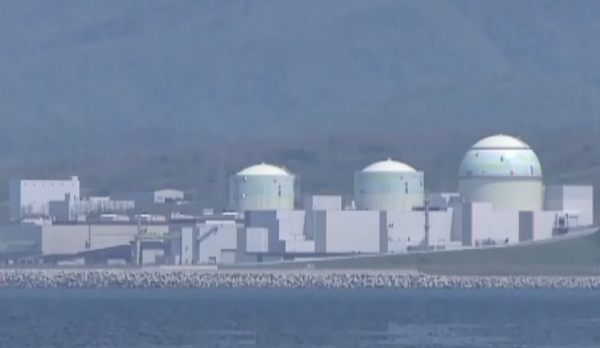
Hokuriku Electric Power Company's Tomari Nuclear Station.
Prevention-machines and manpower
An approach to prevention underway in Japan is similar to that of the United States in one respect; it is recognized that preparation for cataclysmic events that could cause interactions among nuclear units on the same site is of utmost importance (e.g., a hydrogen explosion at Fukushima Daiichi Unit 1 stopped efforts for a time at all other units). To that end, Japanese nuclear plant owners and the Nuclear Energy Institute in the United States recognize that a massive array of stand-by generating trucks (for electric power), fire engines (for water pumping) and other vehicles, as well as personnel and the ability to get all of this to a plant site in short order are necessary developments. And the progress to this end is remarkable in both countries.
In Japan, there is a growing desire to get nuclear plants restarted so that they can provide energy at far lower cost than the fossil fuels that are now being imported. However, no nuclear plants can be started back up until they've passed new safety inspections mandated by the new Nuclear Regulation Authority (NRA) in Japan. Not surprisingly, the plants at which the most upgrade work has been completed are those that have already applied to restart. Seventeen units have applied as of now-see the NRA graphic below.
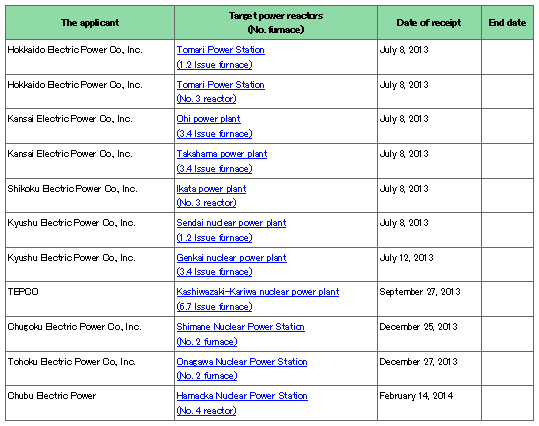
The efforts underway to allow restart are well known; this link details the work done at Tokyo Electric Power Company's giant Kashiwazaki-Kariwa plant and at Chubu Electric Power Company's Hamaoka plant. Since that article was written, the containment vent filters have been delivered to and installed at Kashiwazaki-Kariwa Units 6 and 7. Other plant owners have begun to take steps as well, including Hokkaido Electric Power Company at its three-unit Tomari Nuclear Station, as seen in the graphics below excerpted from an official company report.
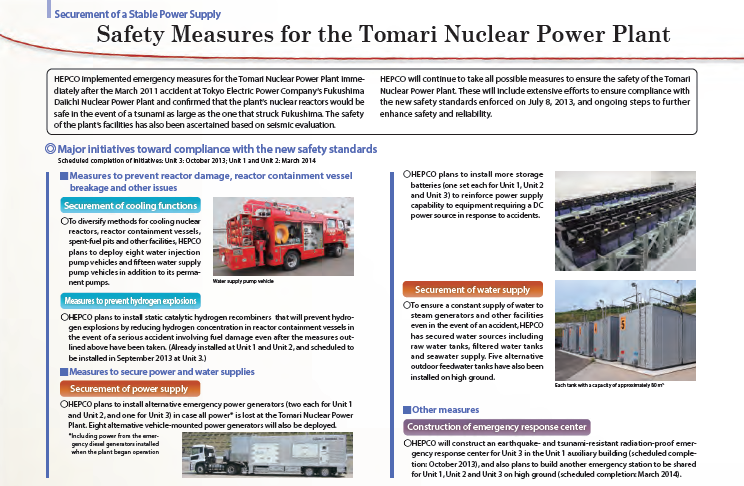
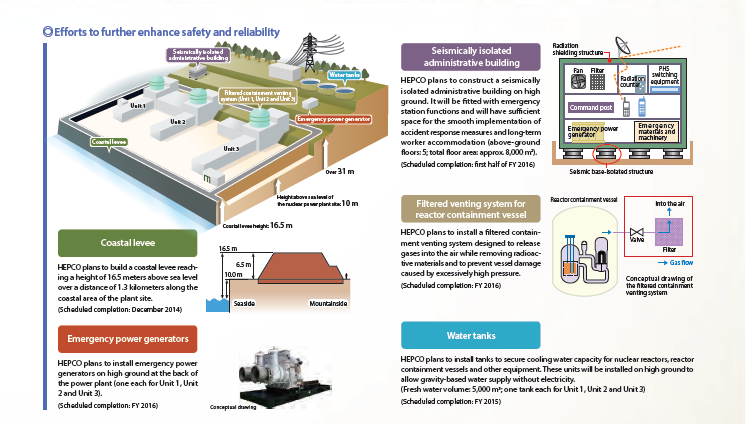
The steps above concerning plant additions to adapt to use of portable power and water supplies, in addition to the mobile supplies themselves, are typical of provisions being made throughout the country.
In the United States, similar work is also in process and showing real progress. By the end of this year, two regional centers, each with five full sets of mobile backup emergency equipment, will be opened. This backs up equipment already bought by and stationed near the nuclear plants themselves; NEI informs us that 20 nuclear plants will complete their FLEX preparations by the third quarter of 2014 in the area of mobile electric power. Twenty plants will also have installed spent fuel pool water level monitoring equipment. Already completed are plant-specific seismic walkdowns and flooding walkdowns; actions resulting from these are all forthcoming. In all, over 1500 pieces of equipment (such as generator trucks and water pump trucks) have been purchased for this FLEX effort, or are on order. NEI reports that all FLEX modifications at all nuclear plants in the United States will be complete by 2016.
In Japan, it's expected that at some plants the modifications and provision of equipment will occur much sooner so that plants can be restarted in the near-term. The NRA has recently bolstered its staff significantly after having merged in an outside professional organization, and with the help of Mitsubishi Heavy Industries, the safety reviews (delineated in the table above) are now well underway. However, it may not in fact be the final safety reviews that hold up restarts. For example, TEPCO's Kashiwazaki-Kariwa plant is assumed in TEPCO's business plan to restart after July this year, but a revisit of the seismic conditions under the plant may take as much as six months by itself. This would push the safety review out at least that long; further, TEPCO may not finish all of the physical upgrades by July either. In a similar fashion, some of the other operators may not complete some large construction projects such as seawalls by summer. What's important to realize is that operators now have safety squarely in mind, and not only do not wish to attempt to restart until it's nearly assured as possible, but cannot do so anyway without NRA approval.
Public 0pinion shifting, people moving
According to a recent Kyodo News poll, 37 local governments in Japan (out of 156 total) would today allow restarts of nuclear plants when the NRA safety checks are passed. This is a surprise, given a continuous flood of negative press covering anti-nuclear sentiment in Japan. This follows the election of a government in Tokyo that is, at the very least, not anti-nuclear, and of course the exploits of Prime Minister Abe who is pushing for the restart of nuclear plants. Abe is also pushing to repatriate displaced families back to areas where safe return is assured.
As reported by NHK World, Abe visited Fukushima Prefecture last week, and held a meeting with persons displaced from Miyajoki District who will be allowed to return home April 1. This step is the first in the real recovery of Fukushima; the "real recovery" isn't just about the nuclear plant, and "Fukushima" isn't a nuclear plant, but a giant prefecture that was and again will be the home to many thousands of people, and the site of farms and villages and fishing ports-just as it was before March 2011. Prime Minister Abe was quoted as saying that the recovery of Japan cannot begin until the recovery of Fukushima is underway, and the progress seen so far as well as the ongoing efforts to ensure future nuclear safety (and thus reliable energy supply, safe living, commerce, and prosperity) are absolute sign posts on the road to a recovery that we all know is coming, and we can just see dawning on the horizon.
For more information:
Utilities Service Alliance: USA Fukushima team ensuring plants can respond
(Above two links contain information provided to International Atomic Energy Agency by the Japanese government.)
OECD/Nuclear Energy Agency: Accident Management Insights after the Fukushima Daiichi NPP Accident
June 2012 TEPCO handout on tsunami protection, other measures being installed at Kashiwazaki-Kariwa
______________________________________
 Will Davis is the communications director for the N/S Savannah Association, Inc. where he also serves as historian and as a member of the board of directors. He is also a consultant to, and writer for, the American Nuclear Society; an active ANS member, he is serving on the ANS Communications Committee 2013-2016. In addition, he is a contributing author for Fuel Cycle Week, is secretary of the board of directors of PopAtomic Studios, and writes his own popular blog Atomic Power Review. Davis is a former US Navy reactor operator, qualified on S8G and S5W plants.
Will Davis is the communications director for the N/S Savannah Association, Inc. where he also serves as historian and as a member of the board of directors. He is also a consultant to, and writer for, the American Nuclear Society; an active ANS member, he is serving on the ANS Communications Committee 2013-2016. In addition, he is a contributing author for Fuel Cycle Week, is secretary of the board of directors of PopAtomic Studios, and writes his own popular blog Atomic Power Review. Davis is a former US Navy reactor operator, qualified on S8G and S5W plants.


